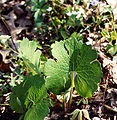Bloodroot
| Sanguinaria canadensis subsp. var. | Bloodroot, Red puccoon | |||||||||||||||||||||||||||||||||||||||||||||||||||||||
|---|---|---|---|---|---|---|---|---|---|---|---|---|---|---|---|---|---|---|---|---|---|---|---|---|---|---|---|---|---|---|---|---|---|---|---|---|---|---|---|---|---|---|---|---|---|---|---|---|---|---|---|---|---|---|---|---|

|
|
| ||||||||||||||||||||||||||||||||||||||||||||||||||||||
| ||||||||||||||||||||||||||||||||||||||||||||||||||||||||
Bloodroot (Sanguinaria canadensis) is a perennial, herbaceous flowering plant native to eastern North America from Nova Scotia, Canada southward to Florida, United States. It is the only species in the genus Sanguinaria, and is included in the family Papaveraceae and most closely related to Eomecon of eastern Asia.
Bloodroot is also known as bloodwort, red puccoon root, and sometimes pauson. Bloodroot has also been known as tetterwort in America, although that name is used in Britain to refer to Greater Celandine.
Bloodroot is a variable species growing from 20 to 50 cm tall, normally with one large, sheath-like basal multi-lobed leaf up to 12 cm across. The flowers are produced from March to May, with 8-12 delicate white petals and yellow reproductive parts. The flowers appear over clasping leaves while blooming. Plants are variable in leaf and flower shape and have in the past been separated out as different subspecies due to these variable shapes; currently most taxonomic treatments lump these different forms into one highly variable species. Bloodroot stores sap in an orange colored rhizome, that grows shallowly under or at the soil surface. Over many years of growth, the branching rhizome can grow into a large colony. Plants start to bloom before the foliage unfolds in early spring and after blooming the leaves expand to their full size and go summer dormant in mid to late summer. Plants are found growing in moist to dry woods and thickets, often on flood plains and near shores or streams on slopes, they grow less frequently in clearings and meadows or on dunes, and are rarely found in disturbed sites. The flowers are pollinated by small bees and flies, seeds develop in elongated green pods 40 to 60 mm in length and ripen before the foliage goes dormant. The seeds are round in shape and when ripe are black to orange-red in color. Deer will feed on the plants in early spring.
Caution: the sap is toxic.
| Standard Cyclopedia of Horticulture |
|---|
|
Sanguinaria (Latin, blood; referring to the yellowish red juice of the plant). Papaveraceae. Blood-Root. Low spring-blooming perennial used for borders and for rock-gardens. Rootstock several inches long, about 1/2 in. thick, horizontal: lvs. radical, cordate or reniform, usually only 1 from each root-bud, on petioles about 8 in. long: fls. white, often tinged with pink, 1-3 in. across, mostly solitary, on scapes about 8 in. long, appearing just preceding the full-grown lvs.; sepals 2, fugacious; petals 8-12, in 2 or 3 rows, oblong or obovate, early deciduous: caps. 1 in. long, oblong, 2-valved.—A single species common in woods of E. N. Amer., running into several forms (see Fedde in Engler's Pflanzenreich, iv, 104). The bloodroot is a showy spring flower usually found in woodland, but not a true shade-loving plant, since its growth is made, to a great extent, before the foliage of the trees expands. In cultivation it prefers a rather light soil, but will grow anywhere. It will do as well in sunlight as in shade and will even grow amongst grass, if care be taken not to mow down the leaves until it has perfected the root growth and buds for the following season. The roots are best transplanted after the leaves have ripened, August-dug and -planted roots being best, but they may be moved when the plants are in flower. The roots are offered at such low prices by collectors that the plant should be used to a much greater extent for spring gardening. Sanguinaria canadensis, Linn. Bloodroot. Red Puccoon. Described above. April, May. Var. major, Hort., is merely a form with large fls. Var. plena, Hort., has more numerous narrower petals. CH
|
Cultivation
Prefers a sandy soil but it is not fussy so long as the ground is not water-logged[1]. Requires a leafy soil in a cool position in the shade of deciduous trees[111, 187]. Thrives in sun or shade according to another report[1]. Plants grow freely in Britain if they are given a suitable site, and have even succeeded in an open position in a dry gravelly soil[4]. Tolerates a pH range from 5 to 7, or perhaps a bit higher[200]. Dormant plants are hardy to at least -20°c[187]. A very ornamental plant[1], but the flowers are very short-lived[187]. It can succeed in grass[1]. Plants are generally free of disease[200]. Polymorphic[1]. There is at least one named form with double flowers[187].
Propagation
Seed - can be sown in the spring or late summer in an outdoor seedbed. We would advise sowing in pots in a cold frame, preferably as soon as the seed is ripe, otherwise in late winter[K]. Stratification can improve germination rates. The seed produces a root after the first stratification but then requires a warm period and another cold one before a shoot is produced. Prick out the seedlings into individual pots when they are large enough to handle and grow them on for at least their first winter in pots. Plant them out into their permanent positions in late summer as they die down. Division in August after the leaves die down[1], or in early spring[111]. The plant has brittle roots and so should be handled carefully[238]. Cuttings of half-ripe shoots in late spring in a frame.
Pests and diseases
Varieties
Gallery
Double-flowered cultivars such as S. canadensis forma multiplex are popular with gardeners, as their flowers last longer than single ones
References
- http://www.pfaf.org/database/plants.php?Sanguinaria+canadensis (Creative Commons Text Source)
- Standard Cyclopedia of Horticulture, by L. H. Bailey, MacMillan Co., 1963
External links
- w:Bloodroot. Some of the material on this page may be from Wikipedia, under the Creative Commons license.
- Bloodroot QR Code (Size 50, 100, 200, 500)



